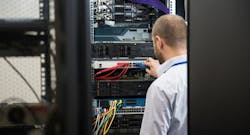EOL & EOSL and Long-Term Hardware Infrastructure Strategy
With close to 25 years of data center and IT expertise, Chad Peters of Service Express shares insights regarding the equipment life cycle and how IT leaders can better prepare their budget, strategy and future projects.
Chad Peters, Data Center & Infrastructure Advisor, Service Express
A new year means it’s time to implement initiatives that will keep your data center up-and-running in 2021 and beyond. When accounting for your IT strategy, how do you account for equipment approaching End of Life (EOL) or End of Service Life (EOSL)? If your team received a hardware alert today, do you know what your plan of action is? Identifying upcoming EOL and EOSL stages helps you plan, explore more options for better decision-making and effectively allocate your IT budget for future initiatives.
What Are EOL & EOSL Dates?
End of Life and End of Service Life strikes an ominous tone. In reality, these terms are misleading. Original equipment manufacturers (OEM) like IBM, HPE and Dell use End of Life and End of Service Life to indicate a stage in the equipment’s life cycle. These are milestones that define the type of support and marketing the OEM offers for equipment.
If a device reaches its EOL or EOSL date, this does not mean it begins slowing down, failing or will stop working on cue. These dates only indicate the end of OEM support and updates. Ultimately, understanding the relationship between the terms and equipment performance helps you know how to prepare for the next EOL or EOSL alert. There are additional options to keep your equipment running despite the loss of updates and OEM support. One of the most common support alternatives for data center equipment approaching EOL or EOSL is third-party maintenance. TPM providers like Service Express have the expertise, flexibility and resources to offer additional support options through the equipment life cycle.
End of Life (EOL)
Once equipment reaches an OEM-designated End of Life date, the OEM no longer markets, sells or releases this equipment. Each manufacturer determines the exact date the life cycle stage takes effect. Hardware typically approaches EOL between years three and six. At this point, additional firmware, patches or upgrades are infrequent. The good news for equipment owners and IT managers is you don’t always need the “latest and greatest” level of firmware or software for your equipment. If you have immediate concerns about your software (bug fixes, security, computability, etc.), resources such as OEM Value-Added Resellers (VARs) can legally provide access to updates through their partner relationship with the OEM. Although not all of these updates are necessary, you should ask your maintenance provider to walk you through what you might need and why.
(Graph: Service Express)
End of Development (EOD)
End of Development means the OEM no longer produces and releases the equipment. Hardware approaches this stage around the six or twelve-year mark. Comprehensive third-party maintenance support continues to keep EOD equipment operational in addition to post-warranty hardware support through the manufacturer.
End of Service Life or End of Support Life (EOSL)
For server, storage and network equipment classified as EOSL, service and updates are no longer offered by the OEM. An EOSL date may apply anywhere between the six to twelve-year mark, depending on the OEM. Take time to determine if a hardware refresh is the best decision for your data center or consider switching to a third-party maintenance provider for ongoing support when an End of Service Life dates approaches.
How to Track EOL & EOSL Dates
EOL and EOSL information may be posted to the OEM website or emailed from their support desk. If you’re unable to find the correct information, you can search over 20,000 equipment dates using an EOL & EOSL Database. This tool makes it simple to find equipment by product, model number or part number, helping you stay on top of your equipment’s critical dates.
What It Means for Your Data Center
For equipment that is approaching EOL or EOSL, don’t panic and rush to replace it. Instead of following the OEM’s lead to refreshing hardware prematurely, explore the alternative support options that are available to you. The good news is that equipment maintains steady performance within an OEM-designed EOL or EOSL timeframe.
Working in data centers around the country, we see equipment’s long-term capabilities every day. At Service Express, we continue to support equipment well beyond its EOL or EOSL date. For example, we support a server that is over 35 years old which only requires one to two service calls a year. For over two decades, we’ve measured when, how and why hardware fails for over half a million devices. Our data shows that equipment is stable over time and does not require a refresh after 7 to 10 years. To learn more about hardware reliability, read our Data Center Frontier article, The Bathtub Curve and Data Center Equipment Reliability.
Building Your Data Center Strategy with EOL & EOSL Dates in Mind
If your 2021 priories have shifted to accommodate budget limitations, increased cybersecurity demands or remote workforce needs, you’ll want to take a strategic look at how to effectively maintain your End of Life and End of Support equipment. You can strengthen your asset management approach and improve the bottom line for your infrastructure budget with a greater understanding of hardware longevity and planning for your equipment’s critical support stages.
Chad Peters is Data Center & Infrastructure Advisor at Service Express.

